INTRODUCTION
The development of new medicines not only is limited to the discovery of new drugs but also includes the development of an adequate delivery system, which is fundamental for the drug to be released in an appropriate place to exercise its therapeutic effect.
An ideal system is that capable of responding to physiological variations, modulating the drug release profile, and the delivery to a specific target in accordance with the therapeutic goal (Bassyouni et al., 2015; Bawa et al., 2009).
An alternative to the treatment of pathologies such as carcinomas, infections, and inflammatory processes that affect the colon is the use of modified delivery systems with the aim of delivering the drug to this region (Paradkar and Amin, 2018; Ravi et al., 2008; Sanghi and Tiwle, 2016; Sharma et al., 2014). In addition to these conditions, drug release in the colon is presented as an alternative for oral administration of peptide drugs and proteins and in chronopharmacotherapy (Bawa et al., 2009; Ravi et al., 2008; Ren et al., 2017; Sanghi and Tiwle, 2016).
In order for the drug to reach the colon region, oral dosage forms should be formulated taking into account the obstacles of the gastrointestinal tract. The strategies used consider characteristics such as pH, enzymatic activity, microflora, and transit time through the gastrointestinal tract (Bassyouni et al., 2015; Sinha and Kumria, 2001; Vandamme et al., 2002).
Due to the advantages of such therapeutic systems, there is growing interest in new excipients with specific technological properties, which may favor drug delivery profiles and adequate bioavailability. Advances in these systems are largely related to the technology of polymers and, among them, natural derivatives or biopolymers have advantages such as excellent biocompatibility, biodegradability, low-cost effectiveness, and respect for the environment (Ali et al., 2014; Dhanya et al., 2012; Huang and Fu, 2010; Kayaci and Uyar, 2012; Ogaji et al., 2011; Sánchez et al., 2011; Sessa et al., 2012). Among the biopolymers, chitosan and zein have been studied with potential pharmaceutical application (Bisharat, 2012; Duggan et al., 2017; Kim et al., 2014).
Chitosan is a polysaccharide consisting of N-acetyl-D-glucosamine and D-glucosamine units obtained by deacetylation of chitin, the main component of the exoskeleton of insects and crustaceans (Azevedo et al., 2007; Kim et al., 2014; Luo et al., 2011; Xu et al., 2015).
Zein, another biopolymer derived from renewable sources, is the main protein found in maize (Luo et al., 2011; Rowe et al., 2009). The predominance of nonpolar amino acids in the composition of zein interferes with its solubility, being insoluble in water (Ali et al., 2014; Shukla and Cheryan, 2001).
The purpose of this research is to promote the technological development of these materials, enabling their application in a modified delivery system aimed at drug release in the colon and the study of its physicochemical characteristics.
MATERIALS AND METHODS
Tablet production
Propranolol hydrochloride was used as a model drug. Tablets containing 40 mg of the drug were obtained through the mixture of microcrystalline cellulose (36.24%), propranolol hydrochloride (26.85%), lactose monohydrate (20.13%), croscarmellose sodium (11.68%), copovidone (3.36%), colloidal silicon dioxide (0.94%), and magnesium stearate (0.81%) and through direct compression (Piccola® Riva® automatic compressor) using a 7 mm circular puncture. The average tablet was 149 mg, with a hardness of 8 kgf, friability less than 1%, and disintegration time of less than 30 minutes.
Dispersion’s preparation
Zein was dispersed in an 80:20 v/v hydroalcoholic solution at a concentration of 2% m/v, with stirring for 60 minutes using a mechanical stirrer. For the coating formulation, talc was added as an antiadherent and triethyl citrate was added as a plasticizer, at a proportion of 10%, to the zein mass (m/m).
Chitosan was dispersed in water, at a concentration of 2% m/v, with stirring for 30 minutes using a mechanical stirrer, pH 4.5 acidified with acetic acid, and Ultra Turrax® for 15 minutes.
Ethyl cellulose aqueous dispersion was diluted with water to 15% m/v, followed by mild stirring for 15 minutes using a mechanical stirrer.
The viscosity of the dispersions was measured using a Brookfield viscometer, using spindle 61, at a speed of 20 rpm and torque of 50%–90%.
Coating
The coating with the zein dispersion constituted the first application layer on the cores. A Vector® perforated drum coater was used for the process, with a 5% increase of film mass in relation to the core. The process parameters were optimized to obtain the best conditions for the coating, and the tablets were evaluated visually, considering the characteristics of film formation, continuous and uniform coating, and the absence of roughness and imperfections.
After application of the zein layer, the tablets were coated with the aqueous dispersion composed of the ethyl cellulose-chitosan blend. The formulations with the different combinations between the polymers and the mass increase with the coating are presented in Table 1. Reduced proportion of ethyl cellulose in the coating it is possible that the coating makes it impossible to control the release from this system, however, with the increase in the proportion of chitosan improves the characteristics of the modified release system but it is still dependent on the applied coating load.
The coating was applied in a perforated drum coater and the process parameters were optimized to obtain the best conditions considering the proposed polymer dispersion characteristics.
In vitro dissolution
The dissolution profiles of formulations F1 to F4 were performed in triplicate using the dissolver, Sotax® AT7 smart, with apparatus II (blades), stirring at 75 rpm, temperature 37.0°C ± 0.5°C, filter 8 μm, and medium volume of 1,000 ml. The dissolution media were prepared to simulate the passage through the gastrointestinal tract. Thus, the dissolution media were used as presented in Table 2, contemplating 24 hours of analysis.
The aliquot collected at each of the given times was analyzed in a UV spectrophotometer. The absorbances were measured for quantification of the active ingredient dissolved in 289 nm, corresponding to the highest intensity signal. The calibration curve was constructed with concentrations of 5, 10, 20, 40, and 60 mg l−1 of the propranolol hydrochloride standard.
Tablet cores coated with the zein and chitosan polymers in isolation were also analyzed through the dissolution profile, considering the same conditions as those carried out for F1–F4.
Polymeric films characterization
The films of the isolated polymers and of the ethyl cellulose-chitosan mixture were prepared by the casting method and the solvent evaporation method and characterized by infrared spectroscopy, differential scanning calorimetry (DSC), thermogravimetry, and mechanical analysis.
Obtaining the films: casting
Aliquots (10 ml) prepared in 2.2 of each formulation were placed on a Teflon® plate and submitted to a temperature of 45°C for 24 hours. After the formation, the films were carefully removed from the plate (Gruetzmann and Wagner, 2005).
 | Table 1. Proportion between ethyl cellulose and chitosan polymers and coating load. [Click here to view] |
 | Table 2. Media, time, and collection of the in vitro dissolution test of coated tablets. [Click here to view] |
Infrared spectroscopy [Fourier-transform infrared spectroscopy (FTIR)]
The polymers, zein, chitosan, and isolated ethyl cellulose, in the form of powder and films, and the ethyl cellulose-chitosan mixture, in the form of powder and film, were characterized by infrared spectroscopy, using a PerkinElmer FT-IR Spectrometer Frontier spectrometer. The spectra were recorded on a spectrometer with scanning in the region of 500–4,000 cm−1.
Thermal analyzes
The measurements to obtain the DSC and thermogravimetric (TGA) curves for the polymer films were carried out on a PerkinElmer Simultaneous Thermal Analyzer 6000 Differential Scanning Calorimeter. Approximately 10 mg of the sample was heated to 70°C, maintaining this condition for 5 minutes. After this period, the sample was heated to 650ºC at a rate of 20ºC minutes−1 with a nitrogen flow of 20 ml minutes−1. The temperature at which the thermal degradation of the polymers occurs was evaluated from the TG curves.
Mechanical analysis
The traction properties, to determine the strain-deformation of materials, were determined using a texture analyzer, the Texture Analyser- Heavy Duty Plus texturometer, Stable Micro Systems, based on the standard ASTM D882 method adapted (ASTM D882, 2002). A load cell of 5 kgf was applied, a traction ratio of 0.1 mm second−1 and an initial distance of 15 mm between the claws. The data recorded are the average of five measurements for each sample with dimensions of 25 × 10 mm.
Water vapor transmission (WVTR)
The WVTR was determined by the standard gravimetric method E96/E96M for the zein films and the ethyl cellulose-chitosan mixture. Using the desiccant method, the test sample is sealed to the open nozzle of a test vessel containing a desiccant, and the assembly is placed in a controlled atmosphere. Periodical weighing determines the movement rate of water vapor through the sample to the desiccant (ASTM E96-E96M, 2010).
We placed 10 g of blue silica gel in 60 ml vials. These were sealed with the films and placed inside a desiccator, which contained 200 ml of calcium chloride saline 10% (m/v). After this procedure, vacuum was performed in the desiccator and it was taken to the incubator at 25°C. The samples were weighed, and a new vacuum was performed during five consecutive days.
The WVTR was calculated by the equation
transmissão de vapor de água = G t−1A−1, where G = mass change, in grams (g); t = time, in hours (h), G t−1 = line inclination (g hour-1), and A = test area (nozzle area), in square meters, obtaining the WVTR ratio in g hour−1 m−2 (ASTM E96-E96M, 2010).
RESULTS AND DISCUSSION
Coating
The polymer suspensions used in the tablet coating were prepared considering their solubility, pH, and viscosity characteristics. The ideal suspension for zein application was composed of hydroalcoholic solution as solvent and 2% zein mass in relation to the solvent volume, obtaining viscosity of 6 cP. For chitosan, the best condition was achieved using purified water as a solvent, pH 4.5 acidified with acetic acid, and 2% chitosan mass in relation to the solvent volume, obtaining a viscosity of 177 cP. The ethyl cellulose aqueous dispersion needed to be diluted to 15% m/v with water and to be then incorporated with the chitosan dispersion.
The first coating layer, composed of zein, had a continuous coating of polymeric film and allowed the core of the second coating layer to be isolated. This technique became necessary as the aqueous coating of ethyl cellulose-chitosan, applied directly to the cores, caused wear and imperfections. This incompatibility is due to the high water solubility of the tablet constituents. After optimization steps, the process parameters for coating application were defined, and they are presented in Table 3.
After the sealing of the nuclei with a layer of zein, it was possible to apply the coating with the ethyl cellulose-chitosan mixture, presenting uniform coating and smooth appearance with no imperfections.
The process parameters that obtained satisfactory results for the application of the coating with the suspension composed by the ethyl cellulose and chitosan blend are presented in Table 4.
In vitro dissolution profile
Uncoated tablets containing the drug propranolol hydrochloride present immediate drug release, with dissolution time of less than 30 minutes, due to its high solubility characteristic (biopharmaceutical classification I) (Farmacopéia Brasileira, 2019). Thus, propranolol hydrochloride was used as a model drug where the delay in release was due exclusively to the action of the proposed coating.
The dissolution profile of the tablets coated with zein, chitosan, and ethyl cellulose, corresponding to the formulations F1–F4, is presented in Figure 1.
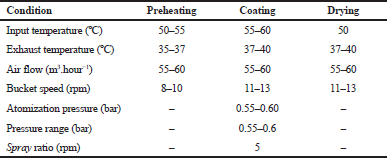 | Table 3. Optimized parameters for the zein coating. [Click here to view] |
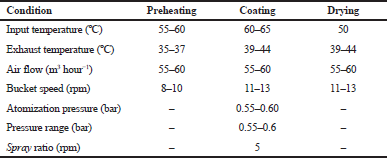 | Table 4. Optimized parameters for the ethyl cellulose-chitosan coating. [Click here to view] |
 | Figure 1. In vitro dissolution profile of propranolol hydrochloride tablets coated with the coating formulations F1–F4. [Click here to view] |
To obtain maximum absorption of the drug in the colon, there should be minimal or null absorption through the gastric mucosa and small intestine and, to this effect, the resistance time in these regions should be considered. Transit of the pharmaceutical form through the stomach ranges from minutes to 2 hours (acidic pH) and, through the small intestine, the transit time is approximately 3–4 hours (Freire et al., 2006; Sanghi and Tiwle, 2016).
Formulations F1 and F2 presented drug release in acidic media, with 84.5% and 86.5%, respectively, dissolved in 2 hours of analysis in 0.1 mol l−1 hydrochloric acid medium, suggesting that the reduced proportion of ethyl cellulose in the coating made it impossible to control the release from this system. From this profile, we can conclude that formulations F1 and F2 are not suitable for modified release, since they indicate that the drug will be released during the passage through the stomach.
It can be observed that the F1 formulation delivered the drug as early as the first hour of the test and the F2 formulation after 1 hour, demonstrating the influence of the coating load on the dissolution profile.
The F3 formulation was shown to be a viable alternative for drug release in the colon, since it presents gastroresistance, referring to the analysis in acidic environment (HCl 0.1 mol L−1), in the period of 2 hours, and 85.2% dissolution of drug occurred after a 5-hour latency period in pH 6.8, sufficient time for the drug to travel through the small intestine to the colon, with 100% of the drug being dissolved in 12 hours of analysis.
For formulation F4, a 16-hour delay in drug release was observed, and it was therefore not of interest for the type of application targeted. The dissolution profile of this formulation is due to the higher coating load in comparison to the F3 formulation.
Monteiro studied the making of matrix tablets prepared with hydroxypropyl methylcellulose and pectin, containing quercetin for colon-specific delivery, and obtained a promising formulation with 75.45% quercetin release in 8 hours of analysis, considering the dissolution media hydrochloric acid 0.1 mol l−1 and phosphate buffer pH 6.8. (Monteiro et al., 2007; Ren et al., 2017), studied a bilayer-coated tablet of chitosan/gelatin and Eudragit® in tablets and completely released in a 24 hours.
In a study performed with microspheres formed of chitosan, Eudragit®, and diclofenac sodium and coated with Eudragit®, a continuous release was obtained during a period of 8–12 hours for colon-specific delivery (Deshmukh and Naik, 2013). Tilkan and Özdemir (2017) investigated the parameters affecting the release of flurbiprofen from chitosan microspheres and obtained between 8 and 12 hours for delivery.
When the polymers were analyzed in isolation, both the zein and chitosan coating presented drug release in 0.1 mol l−1 hydrochloric acid dissolution medium, even when a 15% coating load was used. In contrast, ethyl cellulose in an isolated manner was insoluble in the dissolution medium, not delivering the active ingredient.
The application of ethyl cellulose becomes interesting with the incorporation of permeation enhancing agents due to its insolubility characteristic (Meng et al., 2012). Thus, the combination of ethyl cellulose and chitosan is a viable alternative since it allows the modulation of the release according to the desired therapeutic objective.
Terebesi (2006) performed the coating with an alcoholic solution of zein and 20% coating load on pellets containing theophylline and obtained release of more than 90% of the drug in 6 hours at pH 1.2. At pH 6.8, only 25% of the total drug was delivered in 8 hours with zero order release kinetics. The difference in drug release was attributed to the difference in permeability of the zein film in the different media since the drug has solubility independent of pH. The behavior was associated with the type of ion present in the medium that caused the interaction with the zein structure, producing a barrier of hydration (Terebesi, 2006).
Chitosan is a biopolymer that has been studied as a support material for drug release in the colon due to its complete digestion by bacteria, its sensitivity to pH, and low toxicity (Duggan et al., 2017; Kim et al., 2014; Zhang et al., 2002), making it useful as a support for obtaining an effective colon-specific delivery.
The release kinetics of the F3 formulation was evaluated considering the available mathematical models, which relate the amount of drug delivered as a function of time from the therapeutic system considered.
The criterion used to choose the model that best describes the dissolution phenomenon was the correlation coefficient (R). In this context, it was observed that the model proposed by Weibull obtained R = 0.997, being the model that best fits the profile presented in F3.
The model proposed by Weibull expresses the cumulative fraction of the drug in solution over time and mathematically describes the drug release. However, transport and release sometimes involve multiple steps caused by different physical or chemical phenomena, making it difficult to relate a mathematical model that adequately characterizes the kinetic properties of dissolution, considering the complex set of events that occur by the time the total amount of the drug contained in the pharmaceutical form has been delivered.
Considering the characteristics of the polymeric materials used in this study, we observed that the combination of soluble and insoluble polymers carries out the drug release based on swelling of the coating film along the gastrointestinal tract, erosion, and degradation of the polysaccharide in the colon. These results corroborate the data obtained by Vandamme et al. (2002).
Ethyl cellulose acts as an insoluble material, allowing the gastroresistance of the formulation, while chitosan promotes gradual swelling and delivery specific to the type of therapeutic action proposed.
Characterization of polymeric films
Infrared spectroscopy (FTIR)
The FTIR spectra obtained for zein in powder form and in film form are presented in Figure 2.
The spectrum has characteristic bands of protein. The band at 1,650 cm−1 corresponds to the carbonyl stretch (C=O) of the amide group (amide I), and the band at 1,540 cm−1 is called amide II and is related to the angular deformation vibrations of the NH bond. This band has a lower frequency than that of the band corresponding to C=O. The band at 1,230 cm−1 is relative to the axial deformation vibrations of the C-N (amide III) link. The presence of a high amount of a secondary structure of α-helices is confirmed by the symmetrical spectral band at 1,650 cm−1. Between 2,800 and 3,500 cm−1, bands appear relative to the NH and OH stretches of the protein amino acids (Ali et al., 2014; Silverstein et al., 2013; Yao et al., 2009).
Evaluating the spectrum of zein in the form of powder and film, similarity is observed in the spectra, demonstrating that the chemical composition between the preparations is the same. The change in the band at 1,250 cm−1 relates to the different conformations of the polymers between the two preparations (powder and film). The addition of plasticizer (C12H20O7), for the formation of the film, has main absorption spectrum at 3,000 cm−1 and 1,750 cm−1 and between 1,500 and 1,000 cm−1, with these overlapping the absorption bands of the polymer.
The spectrum in the infrared region of the chitosan biopolymer is presented in Figure 3. Analyzing the spectrum, bands that are characteristics of the material can be verified in the region between 1,700 and 1,300 cm−1. At 1,650 cm−1, the band is attributed to the C=O axial deformation of the carboline of the acetamide group, to which the acetylated part of the chitosan corresponds. In this same region, amide groupings and OH groups appear, overlapping the N-acetyl group. Significant alterations in this region are observed, attributed to the conformations of the polymers, differentiating the material between the form of powder and film.
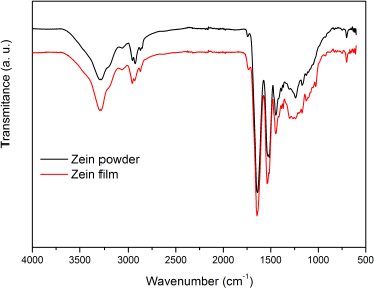 | Figure 2. FTIR spectra obtained for zein in the form of powder and film. [Click here to view] |
The band at 3,440 cm−1 is attributed to the hydroxyl group (OH) axial stretching hydrogen bonds, and this appears overlapping the NH stretch band. Comparatively, there is a change in the band relative to the OH grouping, between the powder and film forms, due to the different interactions between the hydroxyls in the two preparations.
In relation to the pyranoses, we can observe vibrations between 1,200 and 800 cm−1 that are associated to the chemical bonds and bands in the region of 2,850 cm−1 that are attributed to the groups CH2. The bands in the region between 1,300 and 1,400 cm−1 correspond to the symmetrical angular deformation of the CH3 group (Sánchez et al., 2011; Silverstein et al., 2013).
In the preparation of the polymeric film, plasticizer and acetic acid were used. The plasticizer (C12H20O7) has characteristic bands at 3,000 cm−1 and 1,750 cm−1 and in the region between 1,500 and 1,000 cm−1, and acetic acid (CH3COOH) has characteristic bands at 3,000 cm−1 and in the region between 1,700 and 1,300 cm−1, which corroborate differences of intensity in the overlapping regions.
In the FTIR spectra obtained for ethyl cellulose, presented in Figure 4, characteristic hydroxyl (OH) bands can be identified at approximately 3,500 cm−1 and between 2,974 cm−1 and 2,869 cm−1, bands appear referring to the C-H stretch. Other important bands are shown at 1,090 and 1,370 cm−1, corresponding to the C-O-C stretch and the C-H flexion, respectively. Bands between 1,200 and 800 cm−1 are associated with the chemical bonds of the pyranoses, and bands in the 2,850 cm−1 region are assigned to the CH2 groups (Silverstein et al., 2013; Trivedi et al., 2015).
The presence of plasticizer in the film can clearly be identified based on the band of the ester groups. The most expressive peak, at 1,750 cm−1, belongs to the vibrations C=O. The other characteristic bands of the plasticizer coincide with the ethyl cellulose absorption regions, with the OH grouping band and C-O-C vibration of the ester group (Hegyesi et al., 2013). Subtracting the plasticizer spectrum, we observed that the band characteristic of ethyl cellulose is unchanged comparing the spectra of the form powder and film, demonstrating that there are no significant changes in their functional groups.
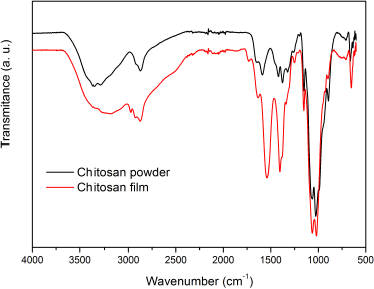 | Figure 3. FTIR spectra obtained for chitosan in the form of powder and film. [Click here to view] |
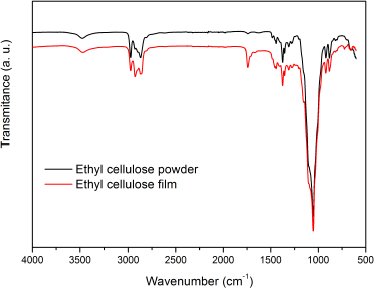 | Figure 4. FTIR spectra obtained for ethyl cellulose in the form of powder and film. [Click here to view] |
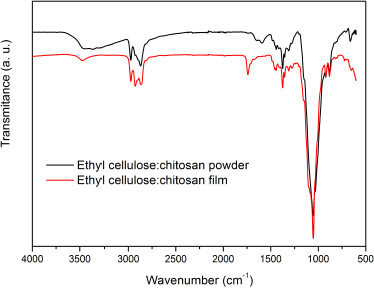 | Figure 5. FTIR spectra obtained for the ethyl cellulose-chitosan mixture in the form of powder and film. [Click here to view] |
In order to evaluate the interactions between the functional groups of the polymers used in the mixture, FTIR analysis (Fig. 5) was performed for the physical mixing of ethyl cellulose and chitosan powders and after casting.
By evaluating the spectrum, characteristic bands in common among the polymers as presence of hydroxyl, pyranoses, stretch C-H, group CH3, and vibration C-O-C of the ester group can be observed. No significant changes were observed in the blend in relation to the isolated polymers.
The inclusion of plasticizer in the film production can be identified at 1,750 cm−1, the band that characterizes the C=O vibrations of triethyl citrate.
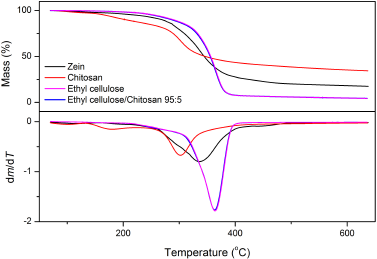 | Figure 6. TGA curves for zein, chitosan, and ethyl cellulose. [Click here to view] |
Thermal analyzes
The degradation temperature of the polymers is demonstrated by the TGA curves, with the loss of mass versus temperature and its derivative function presented in Figure 6.
Thermal degradation of polymers occurs in more than one stage. The highest thermal stability corresponds to the ethyl cellulose sample, with a maximum loss of mass at approximately 375ºC and, on the contrary, the chitosan sample presented lower thermal stability, with a maximum loss of mass at approximately 300ºC and slight loss at 175ºC. This initial loss of mass may be related to loss of volatile compounds, such as water and acetic acid.
However, when ethyl cellulose and chitosan are mixed in the proportion of the application, they have a degradation profile as that presented for isolated ethyl cellulose, demonstrating that the addition of chitosan does not interfere in the thermal stability of the mixture.
The data presented in this evaluation complement the results obtained in the FTIR analysis, demonstrating that the chemical interactions are maintained, being indicative that there were no incompatibilities between the materials used in the mixture.
Zein presented a thermal stability profile intermediate to that of chitosan and ethyl cellulose, with mass loss beginning at 290°C and maximum degradation ratio at approximately 320°C.
As for the energy processes, it was not possible to observe significant changes, through the DSC for the studied polymers.
Mechanical analyses
The mechanical behavior of the polymers can be viewed easily by observing their stress–strain curve. The curves obtained for the isolated films and for the ethyl cellulose-chitosan mixture are presented in Figure 6, and the results in terms of the Young modulus and yielding point are presented in Table 5.
The stress versus strain curves demonstrate that the studied materials present different behavior when submitted to mechanical traction. Comparatively, chitosan is the less deformed and more rigid material; on the other hand, ethyl cellulose has a high strain with a low tension and behaves in a more elastic way.
These results can also be visualized in Young's modulus, which indicates the level of stiffness of the polymer; that is, the larger the modulus value, the greater the stiffness. In this perspective, it can be observed that the chitosan presented the highest value (7,000 GPa) and ethyl cellulose the lowest value (0.666 GPa).
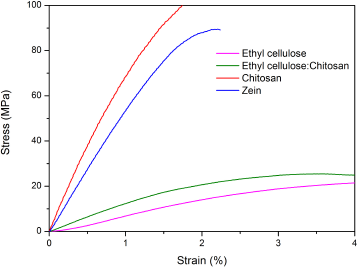 | Figure 7. Tension-deformation curves of polymeric films. [Click here to view] |
 | Table 5. Mechanical properties of the polymer films for Young's modulus and yielding point. [Click here to view] |
When mixed, the results of ethyl cellulose-chitosan, in the proportion of the application, demonstrate that the mechanical behavior, demonstrated in the stress–strain curve, becomes intermediate to that of the isolated polymers. The addition of chitosan provided an increase in Young's modulus, demonstrating that greater intermolecular interaction occurs in the resulting material of the blend.
It can be observed that the proposed mixture did not present significant changes in the thermal analysis and FTIR; however, the modification of the material can be observed when its mechanical behavior is analyzed. The increased interactions between the macromolecules contribute to increase the film's resistance.
In relation to the yielding point, presented in Table 5, it can be observed that the lowest value refers to the zein film. This parameter indicates the stress that the material undergoes until the plastic deformation begins and defines the yielding power of the polymer molecules during the stretching. The yielding point for the ethyl cellulose-chitosan mixture presented a lower value than the isolated polymers, demonstrating the lower molecular mobility that results in increased resistance.
Water vapor transmission (WVTR)
The WVTR results for the zein films and for the ethyl cellulose-chitosan mixture were 304.76 g hours−1 m−2 and 304.46 g hours−1 m−2, respectively. Thus, the statistical difference between the films is not significant (p ≤ 0.05).
Ethyl cellulose absorbs extraordinarily little water from moist air or during immersion, and the small amount is evaporated rapidly, thus presenting utility as a moisture barrier improving the stability of the formulation. It can be observed that the zein film is like that of ethyl cellulose in water transmission value, and this characteristic shows that zein presents good prospects to be used as a moisture barrier.
This property of zein, in large part, is related to its hydrophobic characteristic, due to the predominance of nonpolar amino acids and of the homogeneity of the polymeric matrix (Ali et al., 2014) (Kayaci and Uyar, 2012; Mehta and Trivedi, 2012; Shukla and Cheryan, 2001). In general terms, a coating material with low water vapor permeability is interesting, since it allows a more prolonged stability for drugs that are sensitive to this environmental condition, providing a longer shelf life for the drug. It is also interesting as a sealing layer, separating incompatible components. This property of zein, in large part, is related to its hydrophobic property (Kayaci and Uyar, 2012; Mehta and Trivedi, 2012; Shukla and Cheryan, 2001). In general terms, a coating material with low water vapor permeability is interesting because it allows a longer stability for drugs sensitive to this environmental condition, providing a longer shelf life for the drug.
CONCLUSION
The application of natural polymers is interesting raw materials for pharmaceutical application; we found that use of zein exhibits film-forming properties, impermeability, and ease of coating application and can be used as a sealing layer to protect the core containing the drug from incompatible materials and as a barrier against moisture. This feature is interesting, from the point of view of pharmaceutical technology, since a material with a moisture barrier allows the protection of drugs that are sensitive to this environmental condition.
The in vitro dissolution data presented demonstrated that it is possible to obtain coated tablets for release in the colon, containing polymer blend with physicochemical characteristics and different delivery systems, as is the case of chitosan and ethyl cellulose. Chitosan has characteristics that allow its degradation by the microflora what possibilities applicability in a specific colon delivery system. The combination between the proportion of the polymers and the percentage of coating load that presented the best result was the ratio of 95:5 ethyl cellulose/chitosan and 5% coating load.
The results obtained for thermal stability and FTIR presented no incompatibility in the films used, and the thermal stability of ethyl cellulose was maintained in association with chitosan. The mechanical profile of the polymer films for deformation and stretching demonstrated that, with the proposed mixture, there is an increase of Young's modulus and, therefore, a greater intermolecular interaction between the materials, allowing for good application characteristics in tablets.
It can be concluded that the zein and chitosan biopolymers have desirable characteristics for tablet coating application and, with the study performed, the application in a system for drug release in the colon.
ACKNOWLEDGMENTS
The Research Department, Development, and Innovation of the Pharmaceutical Industry Prati Donaduzzi Ltd. Co., in the city of Toledo, Paraná, and the Federal Technological University of Paraná, Toledo and Medianeira campus. The authors thank Central Analytical Facility (LABCA) for the support.
AUTHOR CONTRIBUTIONS
All authors made substantial contributions to conception and design, acquisition of data, or analysis and interpretation of data; took part in drafting the article or revising it critically for important intellectual content; agreed to submit to the current journal; gave final approval of the version to be published; and agree to be accountable for all aspects of the work. All the authors are eligible to be an author as per the international committee of medical journal editors (ICMJE) requirements/guidelines.
CONFLICT OF INTEREST
The authors report no financial or any other conflicts of interest in this work.
FUNDING
This study was financed in part by the Coordenação de Aperfeiçoamento de Pessoal de Nível Superior – Brasil (CAPES).
ETHICAL APPROVALS
This study does not involve experiments on animals or human subjects.
PUBLISHER’S NOTE
This journal remains neutral with regard to jurisdictional claims in published institutional affiliation.
REFERENCES
Ali S, Khatri Z, Oh KW, Kim I, Kim SH. Zein/cellulose acetate hybrid nanofibers: electrospinning and characterization. Macromol Res, 2014; 22(9):971–7.
ASTM D882. Standard test method for tensile properties of thin plastic sheeting. ASTM, West Conshohocken, PA, 2002.
ASTM E96-E96M. Standard test methods for water vapor transmission of materials. ASTM, West Conshohocken, PA, 2010.
Azevedo VV, Chaves SA, Bezerra DC, Lia Fook MV, Costa AC. Quitina e quitosana: aplicações como biomateriais. Rev Elet Mat Proc, 2007; 2.3:27–34.
Bassyouni F, Elhalwany N, Rehim MA, Neyfeh M. Advances and new technologies applied in controlled. Res Chem Intermed. 2015; 42:2165–200.
Bawa P, Pillay V, Choonara YE, Du Toit LC. Stimuli-responsive polymers and their applications in drug delivery. Biomed Mater, 2009; 4:1–15.
Bisharat LMN. An investigation into the use of zein proteins as pharmaceutical excipients for modified drug release application. Thesis (Doctor) - School Of Pharmacy, University Of East Anglia. [ONLINE] 2012. Available via: https://ueaeprints.uea.ac.uk/id/eprint/39448/1/2012BisharatLMNPhD.pdf. (Accessed 30 March 2021).
Deshmukh RK, Naik, JB. Diclofenac sodium-loaded Eudragit® microspheres: optimization using statistical experimental design. J Pharm Innov, 2013; ; 8:276–87. CrossRef
Dhanya AT, Haridas KR, Divia N, Sudheesh S. Development of zein-pectin nanoparticle as drug carrier. Int J Drug Deliv, 2012; 4(2):147–52.
Duggan S, Cummins W, Donovan O, Hughes H, Owens E. Thiolated polymers as mucoadhesive drug delivery systems. Eur J Pharm Sci, 2017; 100:64–78. CrossRef
Farmacopéia Brasileira. (ANVISA). 2019. [ONLINE] Available via: https://www.gov.br/anvisa/pt-br/assuntos/farmacopeia/farmacopeia-brasileira/arquivos/7987json-file-1 (Accessed 28 March 2021).
Freire AC, Podczeck F, Souza J, Veiga F. Liberação específica de fármacos para administração no cólon por via oral. I - o cólon como local de liberação de fármacos. Rev Bras Cienc Farm, 2006; 42:319–35. CrossRef
Gruetzmann R, Wagner KG. Quantification of the leaching of triethyl citrate/polysorbate 80 mixtures. Eur J Pharm and Biopharm, 2005; 60:159–62. CrossRef
Hegyesi D, Sovány T, Berkesi O, Pintye-Hódi K, Regdon Jr. Study of the effect of plasticizer on the structure and surface characteristics of ethylcellulose free films with FT-IR spectroscopy. Microchem J, 2013; 110:36–9. CrossRef
Huang S, Fu X. Naturally derived materials-based cell and drug delivery systems in skin regeneration. J Control Release, 2010; 142:149–59. CrossRef
Kayaci F, Uyar T. Electrospun zein nanofibers incorporating cyclodextrins. Carbohydr Polym, 2012; 90:558–68. CrossRef
Kim JK, Kim HJ, Chung J, Lee J, Young S, Kim Y. Natural and synthetic biomaterials for controlled drug delivery. Arch Pharm Res, 2014; 37:60–8. CrossRef
Luo Y, Zhang B, Whent M, Yu L, Wang Q. Preparation and characterization of zein/chitosan complex for encapsulation of α-tocopherol, and its in vitro controlled release study. Colloids Surf B, 2011; 85:145–52. CrossRef
Mehta F, Trivedi P. Formulation and characterization of natural biodegradable chewing gum. Int J Pharm Tech Res, 2012; 4:889–99.
Meng J, Levina M, Rajabi-Siahboomi AR, Round AN, Reading M, Craig DQM. The development of thermal nanoprobe methods as a means of characterizing and mapping plasticizer incorporation into ethylcellulose films. Pharm Res, 2012; 29:2128–38. CrossRef
Monteiro LM, Souza AE, Gianotto EAS, Nery MMF, Duarte JC, Freitas O. Comprimidos matriciais preparados com hidroxipropilmetilcelulose e pectina contendo quercetina para liberação cólon-específica. Lat Am J Pharm, 2007; 26:179–84.
Ogaji IJ, Nep EI, Audu-Peter JD. Advances in natural polymers as pharmaceutical excipients. Pharm Anal, 2011, 3(1):16.
Paradkar M, Amin J. Formulation development and evaluation of colon targeted delayed release methotrexate pellets for the treatment of colonic carcinoma. Braz J Pharm Sci, 2018; 54(4):1–12. CrossRef
Ravi V, Kumar P, Hatna S. Influence of natural polymer coating on novel colon targeting drug delivery system. J Mater Sci Mater Med, 2008; 19:2131–6. CrossRef
Ren YJL, Yang S, Gao S, Yu H, Hu J, Hu D, Mao W, Peng H, Zhou Y. Design and preparation of a novel colon-targeted tablet of hydrocortisone. Braz J Pharm Sci, 2017; 53(2):239–60. CrossRef
Rowe RC, Sheskey PJ, Quinn M. Handbook of pharmaceutical excipients. 6th edition, Pharmaceutical Press, London, UK, 2009.
Sánchez R, Stringari GB, Franco JM, Valencia C, Gallegos C. Use of chitin, chitosan and acylated derivatives as thickener agents of vegetable oils for bio-lubricant applications. Carbohydr Polym, 2011; 58:705–14. CrossRef
Sanghi DK, Tiwle R. Medical rational of colloidal drug, gene delivery and it’s characterization aspects. Int J Innov Drug Discov, 2016; 6:8–17.
Sessa DJ, Selling GW, Biswas A. Reaction of zein with methylenediphenyl diisocyanate in the melt state: thermal, mechanical, and physical properties. Ind Eng Chem Res, 2012; 51:9199–203. CrossRef
Sharma R, Rawal RK, Malhotra M, Sharma AK, Bhardwaj TR. Design, synthesis and ex-vivo release studies of colon-specific polyphosphazene–anticancer drug conjugates. Bioorg Med Chem, 2014; 22:1104–14. CrossRef
Shukla R, Cheryan M. Zein: the industrial protein from corn. Ind Crops Prod, 2001; 13:171–92. CrossRef
Silverstein RM, Webster FX, Kiemle DJ. Identificação espectrométrica de compostos orgânicos. 7th edition, Ltc-Livros Técnicos e Científicos Editora Ltda, Rio De Janeiro, Brazil, 2013.
Sinha VR, Kumria R. Polysaccharides in colon-specific drug delivery. Int J Pharm, 2001; 224:19–38. CrossRef
Terebesi I. 2006. Alternative polymers and processes for coating. Thesis (Doctor) - Freien Universitat Berlin, Berlin, Germany. [ONLINE] Available via: https://refubium.fu-berlin.de/handle/fub188/1707. (Accessed 30 March 2021).
Tilkan MGY, Özdemir N. Investigation of the parameters affecting the release of flurbiprofen from chitosan microspheres. Braz J Pharm Sci, 2017; 53(4):1–12. CrossRef
Trivedi MK, Branton A, Trivedi D, Nayak G, Mishra RK, Jana S. Characterization of physicochemical and thermal properties of biofield treated ethyl cellulose and methyl cellulose. Int J Biomed Mater Res, 2015; 3(6):83–91.
Vandamme TF, Lenourry A, Charrueau C, Chaumeil JC. The use of polysaccharides to target drugs to the colon. Carbohydr Polym, 2002; 48:219–31. CrossRef
Xu L, Huang YA, Zhu QJ, Ye C. Chitosan in molecularly-imprinted polymers: current and future prospects. Int J Mol Sci, 2015; 16(8):18328–47. CrossRef
Yao C, Li X, Song T, Li Y, Pu Y. Biodegradable nanofibrousmembrane of zein/silk fibroin by electrospinning. Polym Int, 2009; 58:396–402. CrossRef
Zhang H, Alsarra IA, Neau SH. An in vitro evaluation of a chitosan-containing multiparticulate system for macromolecule delivery to the colon. Int J Pharm, 2002; 239:1–2. CrossRef